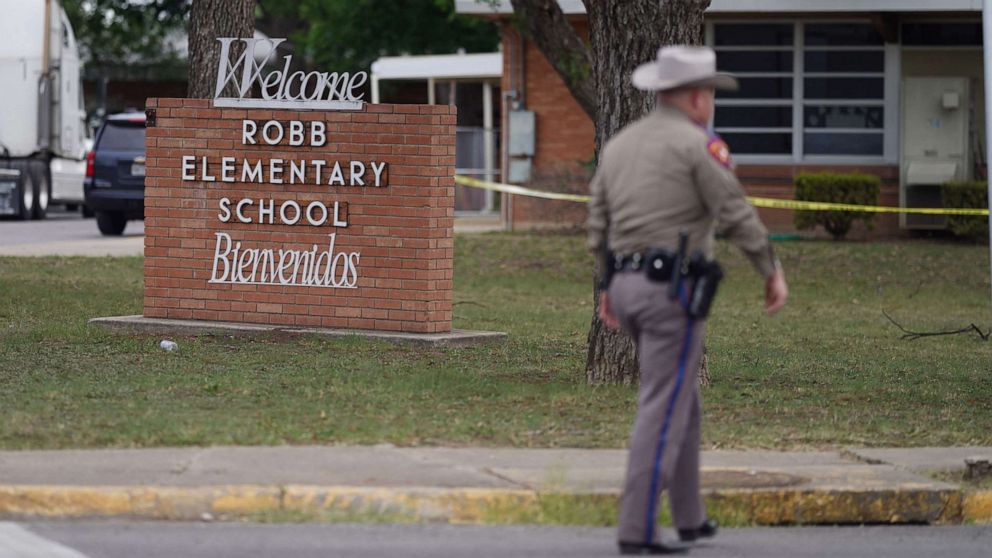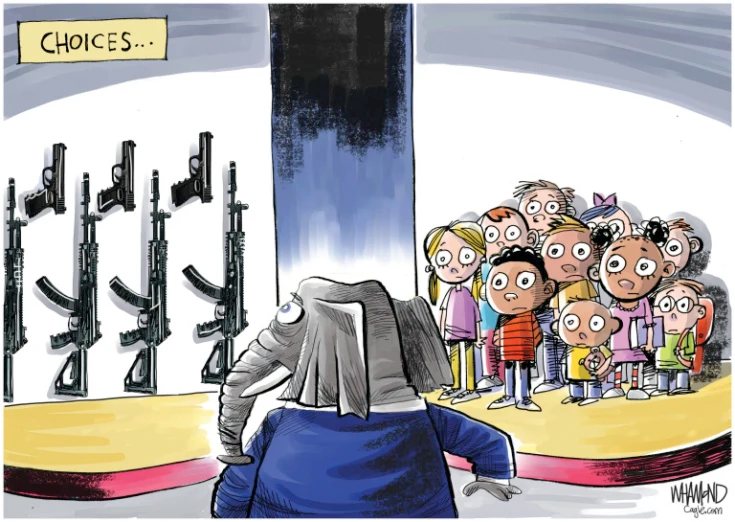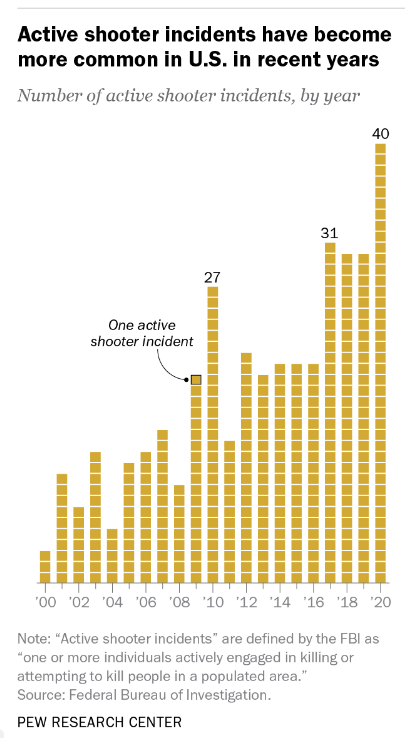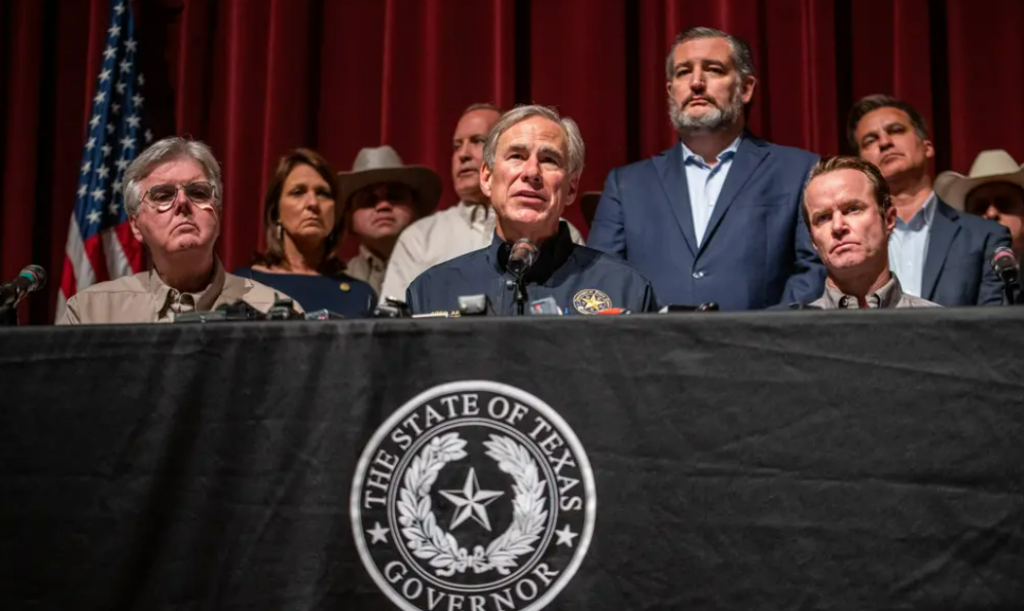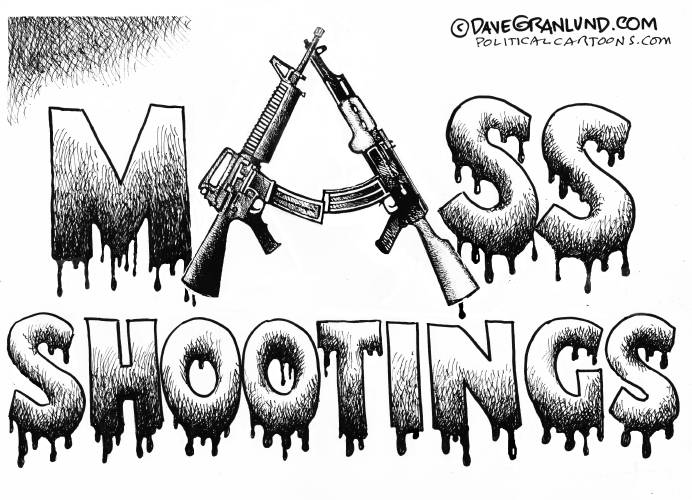Following up the last post on what might reduce gun violence, and what won’t.
There have been several mass shootings since I started this series, including one in a Tulsa hospital a couple of days ago. What we’ve heard so far about that one is that the gunman had recently had back surgery and had been discharged. He had been calling his surgeon asking for help with continued back pain and was not getting a satisfactory response. So he purchased an “AR-15-style weapon” at a gun shop and went to the hospital. He shot and killed his surgeon and another doctor, plus a patient and a receptionist, and then killed himself. So I guess he’s over the back pain now.
A big chunk of our problem appears to be cultural, and I’m not sure how to address that. But culture is somehow driving growing differences between red and blue states. See Paul Krugman, America’s Red State Death Trip, from December 2019.
Democratic-leaning areas used to look similar to Republican-leaning areas in terms of productivity, income and education. But they have been rapidly diverging, with blue areas getting more productive, richer and better educated. In the close presidential election of 2000, counties that supported Al Gore over George W. Bush accounted for only a little over half the nation’s economic output. In the close election of 2016, counties that supported Hillary Clinton accounted for 64 percent of output, almost twice the share of Trump country.
The thing is, the red-blue divide isn’t just about money. It’s also, increasingly, a matter of life and death….
…The death gap has, however, widened considerably in recent years as a result of increased mortality among working-age Americans. This rise in mortality has, in turn, been largely a result of rising “deaths of despair”: drug overdoses, suicides and alcohol. And the rise in these deaths has led to declining overall life expectancy for the past few years.
What I haven’t seen emphasized is the divergence in life expectancy within the United States and its close correlation with political orientation. True, a recent Times article on the phenomenon noted that life expectancy in coastal metropolitan areas is still rising about as fast as life expectancy in other advanced countries. But the regional divide goes deeper than that.
This was before covid, mind you. Covid hit the cities first, of course. But within a few months we were seeing the same red state-blue state death gap, with rates of hospitalizations and deaths from covid far higher in counties that voted for Trump in 2016 than in counties that voted for Clinton. And this trend continues. See For red and blue America, a glaring divide in COVID-19 death rates persists 2 years later by Arielle Mitropoulos, ABC News, March 28, 2022. Experts traced this to political beliefs. Blue state folks wore masks and got vaccinated at higher rates than red state folks, and so there is a death gap.
(I live in one of those red counties. Last week I decided it was time to get a second covid booster, and got it the same day, easy peasy, at no cost at a local Walgreens. Currently the vaccination rate in St. Francois County is only 44 percent, and the current positivity rate is 14 percent.)
Regarding suicide, a few days ago I wrote a post about the Southern Baptist scandal and ended up writing about the rot in the patriarchy. I quoted this:
The data also contains a sociological mystery even the experts are unsure how to explainfully: Of the 45,979 people who died by suicide in the United States in 2020, about 70 percent were White men, who are just 30 percent of the country’s overall population. That makes White men the highest-risk group for suicide in the country, especially in middle age, even as they are overrepresented in positions of powerand stature in the United States. The rate that has steadily climbed over the past 20 years.
Some clinical researchers and suicidologists are now asking whether there is something particular about White American masculinity worth interrogating further.The implications are significant: On average, there are more than twice as many deaths by suicide than by homicide each year in the United States.
Men have tended to have higher rates of suicide than women for a long time, probably since anybody started keeping track of rates of suicide. This suggests to me that in spite of our famous raging hormones, women on the whole tend to be more emotionally stable than men. But it seems to me that the gap between male and female suicides is a lot bigger than it used to be. And, as Krugman says, suicide rates are higher in red states than blue ones. It looks here like the more rural the state, the higher the suicide rate.
Krugman’s column referred to another 2019 column by Thomas Edsall, Red and Blue Voters Live in Different Economies. Much of this column discussed the 2016 election and the argument many of us had at the time about whether support for Trump was driven more by economic anxiety or by racial and cultural animus. Racial and cultural animus was a more obvious reason, but I don’t think you can separate the two. As Krugman pointed out, since 2000 the wealth gap between red and blue voting districts has been growing along with the death gap. Individual Trump voters may be doing perfectly well, but the communities they live in mostly aren’t.
And there is a connection between the economic deterioration and the rise of authoritarianism, along with racism and cultural animus generally. The two things are very much connected. I argued this in 2019 also. “If you want people to not become klansmen and nazis, think about how the economy is working for working-class folks,” I wrote at the time.
Red state voters are angry and think the rest of the country is cheating them or out to get them, somehow. They don’t trust the government except for the Republican side. They watch Fox News and get told everything going wrong is Joe Biden’s fault, or the Squad’s, or Hunter Biden’s laptop, or racial minorities’, or the fault of liberals in general. And the angrier they get the more guns they buy.
Because their states are run by Republicans the kinds of public investments that could attract new high-end business — such as in education and infrastructure — aren’t being made; instead, it’s all about cutting taxes and then cutting education and government services to pay for the tax cuts. So businesses that offer better payings jobs, businesses that require an educated workforce, communities employees want to live in, and good infrastructure, don’t come. It’s a downward spiral. (See How to Kill a State from 2016.)
No wonder “great replacement theory” makes sense to them. From their perspective, there’s not much of a future for them. All the good stuff seems to be diverted elsewhere.
And then there’s good ol’ toxic masulinity. IMO a lot of the male suicide issue stems from a lack of relatable role models for 21st century American men. The old John Wayne / “Dirty Harry” / “Rambo” model of years past really has no function in the modern world. Nobody really needs men who don’t communicate, are emotionally stifled, and solve problems mostly by shooting them. I don’t know that anybody ever needed that sort of man, actually.
I’ve read enough history, and enough Civil War letters, to know that 19th century men weren’t nearly as emotionally frozen as men came to be later. Something happened to American men in the 20th century that wasn’t healthy. Maybe it was the two world wars. I don’t know.
Men, white men especially, are assumed to be the lords of the universe, but most of them aren’t. Most of them are just pawns in the mighty U.S. economy. Their lives are being shaped by forces way beyond their control that they don’t understand. They want to have some control, and they imagine they’ve been cheated of some control or power they should have had. It shouldn’t be a surprise that they seized Donald Trump as a hero, because like any good huckster he knows how to say what people want to hear. Trump articulated their frustration, and they project onto him strength and power and knowledge he doesn’t actually have. But he’s just using them, and they haven’t figured that out yet.
Let’s think about the young folks. We learned that the Uvalde shooter had been the victim of bullying. We also learned he liked to threaten teen girls online.
He could be cryptic, demeaning and scary, sending angry messages and photos of guns. If they didn’t respond how he wanted, he sometimes threatened to rape or kidnap them — then laughed it off as some big joke.
But the girls and young women who talked with Salvador Ramos online in the months before he killed 19 children in an elementary school in Uvalde, Tex., rarely reported him. His threats seemed too vague, several said in interviews with The Washington Post. One teen who reported Ramos on the social app Yubo said nothing happened as a result.
Some also suspected this was just how teen boys talked on the Internet these days — a blend of rage and misogyny so predictable they could barely tell each one apart. One girl, discussing moments when he had been creepy and threatening, said that was just “how online is.”
That’s just how it is. Almost sixty years after Betty Friedan published The Feminine Mystique. I assume a lot of these boys don’t behave that badly around girls in real-world situations — I could be wrong — but all that rage and misogyny doesn’t go away. It’s part of the dysfunctionality of current male role models.
(Right on schedule — Rep. Billy Long, U.S. congressman from Missouri and Trump-endorsed Senate candidate, has declared that all these mass shootings are happening because women have abortion rights.)
All these angry, alienated young men are growing up in angry, alienated cultures, and their parents probably are too wrapped up in their own problems to be much help. They have no useful role models of masculinity to follow, and often the world doesn’t seem to have a place for them. There was a time in their own communities that a young man could graduate high school and pretty much be guaranteed a job at the local factory or mill or mine or quarry, if he couldn’t think of anything else he wanted to do. Often those were Union jobs, so he could expect to sail into adulthood with good wages and benefits that would support a family. Now, more often, there’s nothing but food service and other minimum wage, dead end jobs for this kid, unless he’s willing to move or maybe get some additional training somewhere. The adult world of marriage, maintaining a household and raising a family must seem impossibly far away. That may be why so many seem stuck in adolescence well into their 20s and 30s.
See also Young men, guns and the prefrontal cortex at the Washington Post. This is worth reading all the way through, so I took down the firewall for this one. Basically, it says that the young men are going through adolescence feeling isolated and alienated from everything around them, and our culture doesn’t give them any guidance for handling these feelings except to be macho and aggressive. And, of course, social media acts as a reinforcement for alienation and aggression. Many of them drift into a violent fantasy world in which taking “revenge” on black church goers or Asian women may seem like a fine idea. Further, “for every mass shooter who fits a certain profile, there are millions more like him who never act violently.”
So what can these drifting young men do to feel like men? The firearm industry has an answer. In recent years they’ve increasingly turned to marketing firearms as “objects of masculinity.” And you don’t need a Ph.D. in Freud to see the firearm-phallus connection.
In brief, we’ve got a perfect storm of conditions that cause firearm violence, and there are no quick fixes. Gun control will be only part of it. But making any meaningful change is nearly impossible because of red state culture and the way our Constitutional system allows red states to have veto power over progressive form. Joan Walsh wrote recently of what red state culture has become.
It’s a world where marriage is between a man and a woman, the man is king, LGBTQ people have no rights, and women few. Where abortion is criminalized and the social safety net shredded—so that the women forced to bear children must lean on men, or live in desperate poverty. Where guns are everywhere (parents and teachers should be armed to protect kids!), schools are private, medical care returns to private charities, and only the right (mainly white) kind of people vote. It’s an atomized world, where we rely on male-headed nuclear families, churches, the occasional self-interested generosity of oligarchs, and maybe local, homogenous mutual-aid societies—if we so choose.
It’s the dystopian opposite of the world most Americans want: a world where women, LGBTQ people, and non-white Americans enjoy full citizenship, the right to privacy, autonomy, and the pursuit of happiness. Here, the Second Amendment is respected, but the right to carry lethal weapons is restricted in myriad sensible ways. Everyone who’s eligible can vote here, and everyone over 18 is eligible. And yes, there are churches, synagogues, mosques, and vibrant community-based organizations, but the most effective mutual aid resides in democratically elected governments, local, state, and federal, that guarantee health, safety, education, and economic security for everyone.
Red state culture is something like the last desperate aggressions of a wounded or cornered animal. It’s white supremacy and the patriarchy lashing out at cultural change that leaves no place for them. I’d like to think that in a couple more generations we will all have moved past this nonsense, but I’m not sure the U.S. will survive as a first-world democracy for a couple more generations. We’re living in terrifying times.
